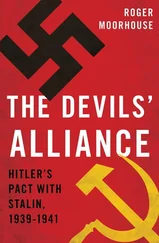Steven Kent - The Clone Alliance
Здесь есть возможность читать онлайн «Steven Kent - The Clone Alliance» весь текст электронной книги совершенно бесплатно (целиком полную версию без сокращений). В некоторых случаях можно слушать аудио, скачать через торрент в формате fb2 и присутствует краткое содержание. Жанр: Боевая фантастика, на английском языке. Описание произведения, (предисловие) а так же отзывы посетителей доступны на портале библиотеки ЛибКат.
- Название:The Clone Alliance
- Автор:
- Жанр:
- Год:неизвестен
- ISBN:нет данных
- Рейтинг книги:4 / 5. Голосов: 1
-
Избранное:Добавить в избранное
- Отзывы:
-
Ваша оценка:
- 80
- 1
- 2
- 3
- 4
- 5
The Clone Alliance: краткое содержание, описание и аннотация
Предлагаем к чтению аннотацию, описание, краткое содержание или предисловие (зависит от того, что написал сам автор книги «The Clone Alliance»). Если вы не нашли необходимую информацию о книге — напишите в комментариях, мы постараемся отыскать её.
Rogue clone Wayson Harris is stranded on a frontier planet-until a rebel offensive puts him back in the uniform of a U.A. Marine, once again leading a strike against the enemy. But the rebels have a powerful ally no one could have imagined.
The Clone Alliance — читать онлайн бесплатно полную книгу (весь текст) целиком
Ниже представлен текст книги, разбитый по страницам. Система сохранения места последней прочитанной страницы, позволяет с удобством читать онлайн бесплатно книгу «The Clone Alliance», без необходимости каждый раз заново искать на чём Вы остановились. Поставьте закладку, и сможете в любой момент перейти на страницу, на которой закончили чтение.
Интервал:
Закладка:
I looked around the kettle, with its eerie shadows and thick metal walls. Naked girders ran the height of its walls. The grenade would not destroy the transport. Kettle walls were designed to withstand missiles. The architects who designed this bird had envisioned bombs exploding outside the fuselage, but I thought that the walls of the kettle would survive the grenade. Even with the floor cut away, there was enough insulation around the fuel supply and engine to protect them from the explosion. The cockpit had blast shields.
I looped my finger into the pin, took a deep breath, and started to pull, but I could not do it. Trying to focus my mind on pulling the pin was like grabbing a wet bar of soap. The thoughts just slipped through my grasp.
“Pull the pin,” I muttered to myself. “Pull the pin.” But every time I tightened my finger around the pin, I suddenly had an irresistible need to check on Freeman or run to the cockpit. It was like my brain purged the thought, and whatever thought filled the void became urgent. I would start to pull, feel a twitch, and momentarily forget what I was doing.
Programming, I realized. Part of the design process for military clones included intricate neural programming. Clones of a later make than I were programmed to see themselves as natural-born humans. They had brown hair and brown eyes, but they saw themselves as having blond hair and blue eyes. To prevent a clone uprising, Congress insisted that they be built with a gland in their heads that would secrete a deadly hormone into their blood if they learned they were clones. They called this the “death reflex.”
My make of clone, the Liberators, had a different gland that released a combination of endorphins and adrenaline into our blood during combat. When things heated up, our hormone helped us think more quickly and clearly. Unfortunately, it proved addictive. Many Liberators became hooked on the hormone and required a fix of violence even after they had won their battles. They attacked prisoners, allies, fellow soldiers. It was the fear of Liberators that caused Congress to build the death reflex in later models.
As a Liberator clone, I was able to recognize my synthetic creation. As a Liberator, I knew that I was built to kill. It had never occurred to me that I had also been programmed to live. I could not force myself to pull the pin from that grenade.
“Well, that is just specking great!” I snarled, and I threw the grenade on the deck, pin and all. I stormed over to the hatch controls. They were intact. All of the transport’s systems checked out in working order except the shields. Hesitating just for a moment, I reached for the button that would open the hatch. If I hit it, the rear of the kettle would split, and Freeman and I would be sucked into space. Death would come in an instant.
But I could not get myself to press the button. It was right there, big and bright red, and shaped like a mushroom, but I could not press it.
“Speck!” I shouted.
Freeman and I had an agreement to kill ourselves rather than return to Little Man. We never thought we would succeed on this mission. We came out to die. Now, thanks to my programming, I could not help but renege. I could not open the hatch or pull the pin.
I would try to fly the transport back to Little Man. What a joke. I was a lousy pilot. I could fly a bird like a Starliner, a civilian craft with simple controls that practically flew itself. This transport, however, had next to no guidance gear. Its nearsighted radar system only had a range of one hundred thousand miles, less than half the distance from the Earth to the moon.
I wasn’t really sure which way to fly to get back to Little Man. With the planet more than four billion miles away, navigation by line of sight was out of the question.
I looked at the load of snacks I had brought back from the vending machine on the broadcast station. A few minutes ago, it had looked like a hoard. Now, in light of the hundreds of hours it would take to fly to that worthless colony, the food seemed insignificant.
I left Freeman unconscious in the kettle and entered the cockpit.
“Unified Authority Transport, come in. Unified Authority Transport, come in.”
I looked down at the radio in complete disbelief. “This is Transport. Who is this?”
“Transport, this is the S.N.N. Sakura . Please hold for Governor Yamashiro.”
I suppose I should have been jumping for joy or saying a prayer to that big municipality in the sky. Instead I laughed. I was four billion miles from a farming colony and untold trillions of miles from civilized space, and whoever had found me wanted me to hold so that I could speak with an old friend. The cavalry had arrived in full force.
“Colonel Harris, is that you?” the familiar old voice asked.
“Yamashiro,” I said. “What the hell are you doing out here?”
“Ah, Harris, that is the question I wanted to ask you. We have been tracking you for some time, and your actions make no sense. Perhaps we can discuss your mission on my ship.”
CHAPTER FOUR
Freeman and I freelanced for the Unified Authority, the pangalactic evolution of the nation that had once been the United States of America. The Unified Authority explored the Milky Way, found that there was no intelligent life in the galaxy other than mankind, and colonized planets in all six of its arms.
As the exploration continued, a fleet of scientific vessels vanished while mapping out a region of the galactic eye. Fearing we had finally located bug-eyed monsters, the U.A. military went on high alert while the Senate called for the creation of a self-broadcasting fleet of battleships.
When the fleet launched, Senate Majority Leader Morgan Atkins, who had championed the project, accompanied it on its maiden voyage. The fleet broadcasted into the innermost curve of the Norma Arm and disappeared.
That was when the Liberators entered the picture. At the same time that Atkins called for his self-broadcasting armada, the Linear Committee—the executive branch of the Unified Authority government—created a superweapon of its own: a new line of military clones. Unlike later clones, which were raised in orphanages, that first batch of Liberators came out of the tube at the age of twenty. They were fast, smart, and more independent-thinking than any clones that had come before them.
To help them confront an unknown enemy, Liberators were built with a “combat reflex.” When the shooting started, a gland inside the Liberators’ skulls secreted a mixture of endorphins and adrenaline into their blood. It made them vicious, but it also kept them thinking clearly during the heat of battle.
Using every self-broadcasting vessel available, the Navy sent these Liberator clones to the Galactic Eye, where they soon discovered that Atkins had founded a colony. He had commissioned the self-broadcasting fleet so that he could hijack it. Morgan Atkins, one of the most powerful men in the Unified Authority, had led the first large-scale rebellion against it.
But he had not known about the Liberators. The clone invasion overran his settlement, forcing Atkins to escape into space with his fleet.
The first Atkins Evangelists appeared a few years after the battle in the Galactic Eye. They told stories about the good senator discovering a city in the center of a planet and making contact with a radiant being who threatened to eradicate mankind. According to Mogat dogma, Atkins signed a pact with his “Space Angel” in which he promised to deliver the Republic as a vassal nation in order to avert total eradication of mankind.
Atkins disciples preached independence from Earth. They called themselves the Morgan Atkins Believers. The government called them “Mogats,” an abbreviation of the name MOrGan ATkins, and dismissed them as cranks.
Читать дальшеИнтервал:
Закладка:
Похожие книги на «The Clone Alliance»
Представляем Вашему вниманию похожие книги на «The Clone Alliance» списком для выбора. Мы отобрали схожую по названию и смыслу литературу в надежде предоставить читателям больше вариантов отыскать новые, интересные, ещё непрочитанные произведения.
Обсуждение, отзывы о книге «The Clone Alliance» и просто собственные мнения читателей. Оставьте ваши комментарии, напишите, что Вы думаете о произведении, его смысле или главных героях. Укажите что конкретно понравилось, а что нет, и почему Вы так считаете.











